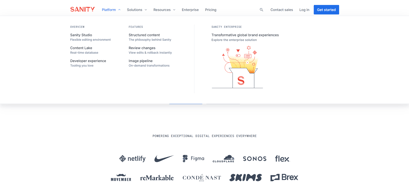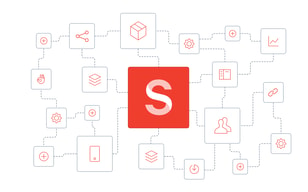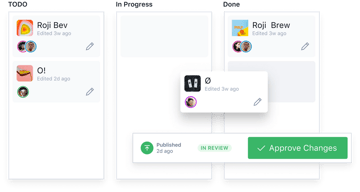

Unclaimed: Are are working at Sanity ?
Sanity Reviews & Product Details
Sanity is a Composable Content Cloud that lets teams create amazing digital experiences at scale. It provides real-time collaboration, live multi-user editing, and track changes. Content creators, designers, and developers can come together while separating content from presentation

| Capabilities |
|
|---|---|
| Segment |
|
| Deployment | Cloud / SaaS / Web-Based |
| Support | 24/7 (Live rep), Chat, Email/Help Desk, FAQs/Forum, Knowledge Base, Phone Support |
| Training | Documentation |
| Languages | English |






Compare Sanity with other popular tools in the same category.

I used sanity at work as a CMS for one of the e-commerce projects and also for my personal projects. I loved how I could structure the data according to the project needs and also it was pretty easy to implement and integrate. Besides that, the real-time collaboration feature stood out, allowing me to monitor live changes to data and contributors. I will always go with sanity first if I need a CMS for my projects
GROQ, the query language used by Sanity, can be complex initially. Also, Sanity does not provide different environments, such as production and staging, which can lead to issues, potentially resulting in unintended alterations to production datasets.
At work, we required a CMS for a significant e-commerce website and were in the process of deciding between Contentful and Sanity. We went with Sanity and was a good decision we made. We successfully added all our products into Sanity, tailoring their structure precisely to our requirements by defining their schema. Additionally, utilizing GROQ for data retrieval proved immensely beneficial, enabling efficient filtering and sorting of the data response. It has made the website fast and easy for our clients to add their products on Sanity.
it's flexibility and ease of use, ease of integration
Nothing but they can improve in various aspects
I use sanity as backend(admin page for managing my content)
Sanity.io's real-time collaboration is a standout feature. The ability to work simultaneously with team members, seeing changes in real-time, fosters a dynamic workflow that enhances productivity and creativity. Additionally, its customizable schemas provide the flexibility needed for diverse projects, allowing us to craft content structures tailored to our exact specifications.
The complexity of more advanced functionalities might pose a slight hurdle for newcomers. While the learning curve isn't steep, delving deeper into certain aspects could benefit from more accessible resources or tutorials. However, community support and active forums often compensate for this, making problem-solving a collaborative effort.
Sanity.io has been a game-changer in content management. By simplifying backend services and offering a robust API, it resolves the challenges of content distribution across platforms. This efficiency not only saves time but also empowers our team to focus on innovation and content creation, ultimately benefiting our business by driving creativity without the hindrance of technical complexities.
Fully customisable with a great community supporting its growth
It can take a while to get set up if you're used to other CMSs that are feature rich
Great usability from a user perspective meaning content teams can be more productive when working in the studio. Has a nice developer experience that can be integrated well with current processes
• Sanity was exactly the kind of headless CMS I was looking for. • Sanity integrates seamlessly with Next.js and Vercel. • I can access my content through the API fairly easily.
Sanity may be challenging for novice programmers to understand. Some written description at the beginning of the documentation regarding the level of programming experience requisite to use Sanity may be helpful as people explore this software.
I have to maintain my professional design portfolio and prefer custom built solutions over drag and drop editors. When I need to update the website styles, I do not want to recreate everything from scratch. I previously used Gatsby and Netlify for my portfolio, but wanted to try a headless CMS. Sanity provides gives me the option to reuse my design portfolio content without locking myself into vendor specific tools or frameworks.
The standout feature of Sanity is its incredible flexibility and customization options. It allows for tailored development environments and empowers content managers without requiring extensive technical know-how. This adaptability sets it apart from other solutions.
While the flexibility of Sanity is a standout, the initial learning curve can be a downside, especially for newcomers. The setup and configuration might pose a challenge initially, but once past that, its benefits outweigh this drawback.
Sanity helps me tackle several business challenges. Its flexibility aids in creating tailored solutions for clients, improving content management efficiency, and streamlining development processes. This versatility enables me to address diverse client needs effectively, leading to enhanced project outcomes and client satisfaction.
Sanity, uses API-first approach, providing developers with the flexibility to use the platform as a headless CMS (Content Management System). This enables seamless integration with various front-end technologies.
While Sanity offers a free plan, there are costs associated with higher usage or additional features. For larger projects with high storage or API usage, the pricing may become a consideration.
Sanity Studio is the web-based interface provided by Sanity for content management and collaboration. It is a key component of the Sanity content platform, offering a user-friendly environment for creating, editing, and managing content.
We've adopted Sanity as our go-to CMS for all of our application and as one of the project managers, digital marketers and content managers for our agency, I think the CMS is on the right track, easy to use and manage applications.
Being in digital marketing, I often miss out-of-the-box features like form submission database/entries like we used to get with Gravity Forms in WordPress or basic SEO features like the ones provided by Yoast SEO in WordPress and while it is great to have control over what we add / don't add, features like the ones I mentioned are vital to any web application and should be a priority.
Our agency is stepping away from the usual WordPress sites which are vunurable to hacking.
Being able to push multiple products from one data set with ease.
Sanity pages that contain large amounts of data are occasionally slow to publish and sync.
Sanity has allowed us to create content codes for internal organization that has helped us mirror content that is created outside the platform.
Incredible documentation, developer experience, and Nextjs integration.
There's not much I dislike about Sanity other than GROQ. It's just another type of query language to learn which is fine but would prefer something different.
Sanity is powering our company website backend. Everything from handling our product schemas to all our copy.





